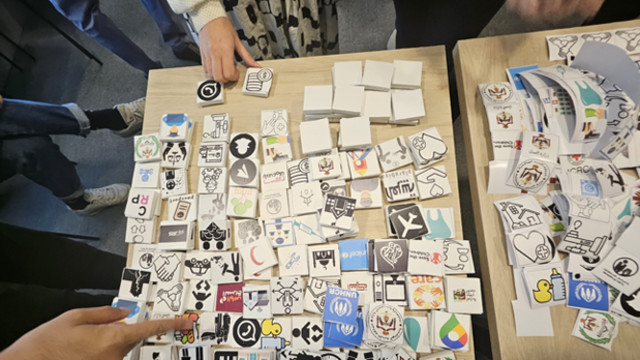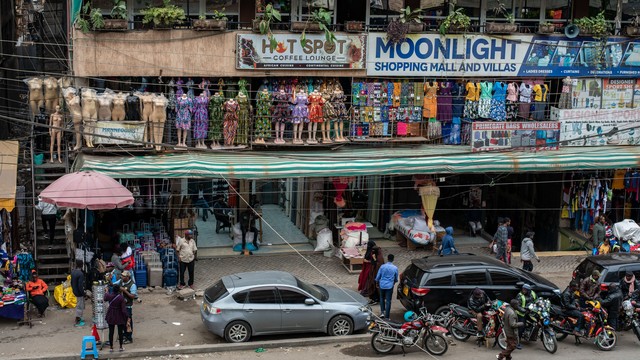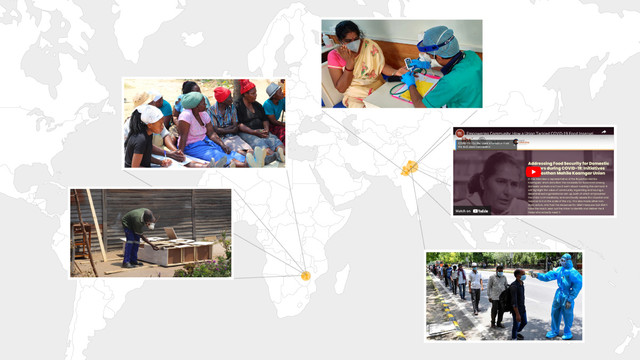Displacement and the pandemic
In our fifth report on emerging lessons from COVID-19, published to coincide with World Humanitarian Day on 19 August, we look at how the pandemic is affecting displaced people.

A centre for refugees in Talbieh, Jordan. Refugees in South Africa, Jordan and in India were excluded from COVID-19 social protection schemes. (Photo: Omar Chatriwala via Flickr, CC BY-NC-ND 2.0)
This article is part of a new IIED series that offers forward-looking responses on key themes during the pandemic, drawing on our partners' insights and providing a platform for voices from the global South.
Here, Deena Dajani looks at how COVID-19 intensifies the risks refugees and displaced people face as they struggle to build dignified lives.
The myth of the pandemic as the 'great equaliser' – a disease that transcends class, power, and privilege – was an attractive one, touted in media coverage and by politicians, implying a possibility of a shared experience across a structurally unequal world.
Myths, as attractive as they are, are feeble attempts to understand the continuities and discontinuities of inequality: the persistence of old forms of inequality and their re-emergence in intensified forms.
In this report, we aim to trace some of these continuities and discontinuities in refugee lives. We focus on displaced persons’ experiences of the pandemic, as an intensification of pre-existing forms of exclusion, and on how multiple and overlapping vulnerabilities need to be understood as compounding risks.
Refugees crossing borders
With the spread of the pandemic, refugees and displaced people found themselves encountering new barriers. Yet more Rohingya refugees died at sea, denied refuge by Malaysia and Thailand as a COVID-19 “preventative measure”. The US government has “indefinitely” effectively sealed the country to refugee resettlement citing “risks of infection from foreigners”.
Across Africa, tens of thousands of displaced people and migrants found themselves in dangerous situations in ports and transit camps as states shut borders to stop the spread of COVID-19.
The weaponisation of a global health crisis to further restrict the routes of refuge offers a stark reminder of what remains unaddressed: the need for an inclusive, just and shared international response to refugee hosting and protection.
Urban refugees
Most displaced people today live in urban areas, generally receiving little or no assistance from the UN or national governments. As Lucy Earle writes, urban refugees are often conveniently assumed to be ‘self-reliant’, an assumption that ignores the multiple risks and vulnerabilities they face, including the difficulty of securing paid work, accessing shelter, healthcare and education.
Urban refugees experience xenophobia frequently, but under COVID-19 the sentiment started to appear in official state responses. In South Africa, Jordan (Arabic website) and India refugees were excluded from COVID-19 social protection programming, including relief packages - despite refugees having no recourse to any humanitarian assistance.
As IIED’s partners SDI Kenya relay in a video produced for this report by their youth group KYCTV, a lack of documentation and appropriate paperwork is a constant obstacle for refugees in Nairobi.
During the pandemic, this took on new intensity: the lack of documentation meant refugees could not benefit from any food distribution or emergency cash relief programmes.
Watch KYCTV’s video below and on IIED's YouTube channel
These interviews are taken from a documentary by KYCTV that explores issues of displacement and reception in the Mathare informal settlement in Nairobi. A trailer for the documentary will be published on 21 August 2020.
The collapse of the informal economy as a result of national lockdowns has hit urban refugees hard, most especially the undocumented. As Robert Hakiza, from the refugee-led organisation Young African Refugees for Integral Development (YARID), explains in another video below, “refugees are more worried about hunger than COVID-19”.
This video is also available on IIED's YouTube channel
Hakiza also reported that YARID has noticed a change in the requests for help and support coming from their community. He says: “People who used to secure their own food and shelter and used to approach us for skills training and education opportunities are now calling us asking for food."
Displacement and the pandemic is the story of how communities live and support each other with minimal resources, in daily struggles “where ‘crisis’ and the ‘everyday’ are not so neatly separable”. What Hakiza’s experience so valuably offers is an understanding of how, in contexts of continuous struggle, the smallest of changes in economic or social environments can have compounding effects.
This is yet another reminder that far from myths of ‘equalising experiences’, an inclusive response to COVID-19 requires us to attend to the legal, political and practical barriers that have long limited the capacity of refugees to build dignified lives.
Resources:
COVID-19 and forced displacement in the Middle East and East Africa, background paper published on the Social Science in Humanitarian Action Platform
Infographics for COVID-19: supporting forcibly displaced people in the Middle East and East Africa, published on the Social Science in Humanitarian Action Platform
Challenges to refugee protection in the time of COVID-19, blog by Liliana Lyria Jubilut
Bringing urban refugees into local planning, blog by Lucy Earle, IIED
The rights and health of refugees, migrants and stateless must be protected in COVID-19 response, joint press release by OHCHR, IOM, UNHCR and WHO
How WHO is supporting refugees and migrants during the COVID-19 pandemic, feature
Global call to action for inclusion of migrants and refugees in the COVID-19 response, article by Mirian Orcutt et al, The Lancet
COVID-19 and the displaced, a compilation by Refugees International
Read more:
Our collection about coronavirus examines some of the emerging impacts of the COVID-19 pandemic on the people and places where we work.



